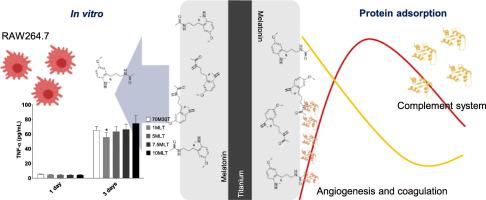Biomaterials Advances ( IF 5.5 ) Pub Date : 2020-07-03 , DOI: 10.1016/j.msec.2020.111262 Andreia Cerqueira 1 , Francisco Romero-Gavilán 1 , Nuno Araújo-Gomes 2 , Iñaki García-Arnáez 3 , Cristina Martinez-Ramos 4 , Seda Ozturan 5 , Mikel Azkargorta 6 , Félix Elortza 6 , Mariló Gurruchaga 3 , Julio Suay 1 , Isabel Goñi 3

|
Melatonin (MLT) is widely known for regulating the circadian cycles and has been studied for its role in bone regeneration and inflammation. Its application as a coating for dental implants can condition the local microenvironment, affecting protein deposition on its surface and the cellular and tissue response. Using sol-gel coatings as a release vehicle for MLT, the aim of this work was to assess the potential of this molecule in improving the osseointegration and inflammatory responses of a titanium substrate. The materials obtained were physicochemically characterized (scanning electron microscopy, contact angle, roughness, Fourier-transform infrared spectroscopy, nuclear magnetic resonance, Si release, MLT liberation, and degradation) and studied in vitro with MC3T3-E1 osteoblastic cells and RAW264.7 macrophage cells. Although MLT application led to an increased gene expression of RUNX2 and BMP2 in 10MTL, it did not improve ALP activity. On the other hand, MLT-enriched sol-gel materials presented potential effects in the adsorption of proteins related to inflammation, coagulation and angiogenesis pathways depending on the dosage used. Using LC-MS/MS, protein adsorption patterns were studied after incubation with human serum. Proteins related to the complement systems (CO7, IC1, CO5, CO8A, and CO9) were less adsorbed in materials with MLT; on the other hand, proteins with functions in the coagulation and angiogenesis pathways, such as A2GL and PLMN, showed a significant adsorption pattern.
中文翻译:

褪黑激素在牙科领域的可能用途:蛋白质对涂层钛的吸附和体外细胞反应。
褪黑激素(MLT)可以调节昼夜节律周期,并且因其在骨骼再生和炎症中的作用而受到研究。将其用作牙科植入物的涂层可调节局部微环境,影响蛋白质在其表面上的沉积以及细胞和组织的反应。使用溶胶-凝胶涂料作为MLT的释放载体,这项工作的目的是评估该分子在改善钛基质的骨整合和炎症反应中的潜力。对获得的材料进行物理化学表征(扫描电子显微镜,接触角,粗糙度,傅立叶变换红外光谱,核磁共振,硅释放,MLT释放和降解),并进行了体外研究MC3T3-E1成骨细胞和RAW264.7巨噬细胞。尽管MLT的应用导致RUNX2和BMP2在10MTL中的基因表达增加,但它并未改善ALP活性。另一方面,取决于所用的剂量,富含MLT的溶胶-凝胶材料在与炎症,凝血和血管生成途径有关的蛋白质吸附中表现出潜在的影响。与人血清一起温育后,使用LC-MS / MS研究了蛋白质的吸附模式。与补体系统有关的蛋白质(CO7,IC1,CO5,CO8A和CO9)在具有MLT的材料中吸附较少;另一方面,在凝血和血管生成途径中起作用的蛋白质,例如A2GL和PLMN,表现出明显的吸附模式。









































 京公网安备 11010802027423号
京公网安备 11010802027423号